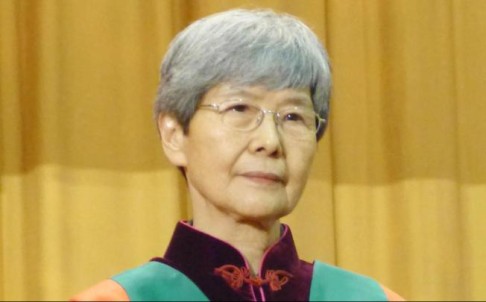Professor Fan, director of Dunhuang Academy in Gansu
Among the six recipients of honorary degrees conferred by the University of Hong Kong last month was Professor Fan Jinshi, director of the Dunhuang Academy in Gansu province, northwest China.
Fan spent half a century in Dunhuang studying and preserving the city's art and manuscripts after she graduated from the Peking University's archaeology department in 1963.
The city is home to the Mogao Grottoes: more than 700 caves full of paintings and Buddhist sculpture spanning a millennium. It is the world's largest on-site art gallery and a Unesco world heritage site.
Dunhuang is situated in the Gobi Desert, known for its harsh climate and living conditions.
For years, Fan lived in a small cave home, with all her furniture made from mud, including her bed, desk and bookcase.
But despite the hardship, she excelled in her research on Dunhuang art, winning global recognition for her outstanding publications as the city gradually gained its name as an icon of Chinese art and culture.
Scholarly studies aside, Fan and her team also put a tremendous amount of effort into preserving the city's art.
This involved the re-vegetation of the area to prevent destruction by abrasive sandstorms, the diversion of saline groundwater away from the paintings to prevent further damage to them, and the digitisation of all the murals.
Digitising the murals did not just produce a permanent record of the artworks, they also facilitated in-depth research on Dunhuang art and life at the crossroads of civilisations during the medieval times.
Fan's years of innovative art preservation efforts have received wide support and global acclaim.
For example, an organisation, Friends of Dunhuang, has been set up in our city to support her efforts, particularly in the mural digitisation programme. Funds have been raised to help finance the work in dozens of caves in the Mogao Grottoes. A similar organisation by the same name exists in the US. It is led by Mimi Gates, the stepmother of Microsoft founder Bill Gates.
For centuries, the city of Dunhuang was considered a gateway to ancient China for caravan traders on the Silk Road.
Many of these traders during the Tang dynasty were Sogdians - the ancient civilisation of Iranian people based in today's Uzbekistan in Central Asia.
These traders ran a logistics business carrying silk from China to the West, and goods, such as wine and gemstones, from Central Asia to China.
In the course of their caravan trade, this group of people also brought Buddhism, Persian music and Western cultural elements into China.
Like ancient Dunhuang, which was considered a centre for trade between China and the West, Hong Kong is also seen as a logistics hub and a gateway to modern China.
For many centuries, trade along the Silk Road flourished, but eventually declined from the 13th century.
One factor attributed to the demise of the Silk Road trade was the occurrence of several wars in Central and Western Asia. Another factor was that over time, other nations eventually learnt the art of producing their own silk, thus eliminating the need for the material to be imported all the way from China.
It was a combination of these, among other factors, that lost Dunhuang its role as the gateway to ancient China.
If we think of Hong Kong as a parallel to the ancient city, there is a lesson we could perhaps take away from Dunhuang's decline.
In this era of rapid globalisation, our city has to ensure that we maintain our competitive edge to stay ahead of the game.
Professor Lee Chack-fan is the chair of geotechnical engineering at the University of Hong Kong

No comments:
Post a Comment